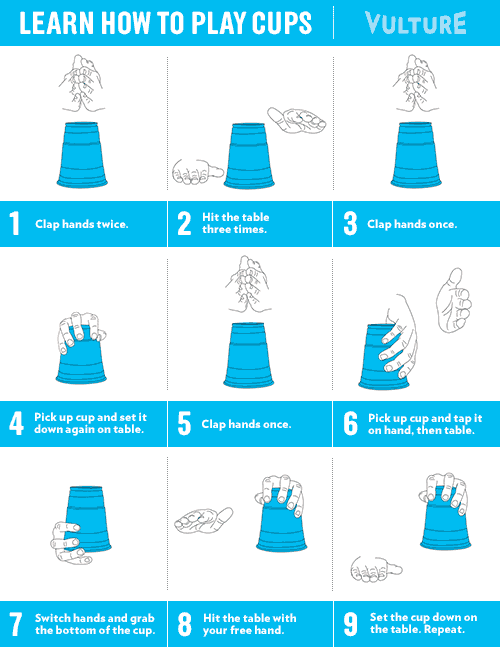Slide versus the Cupsong: where’s Agôn?
Last week I read a chapter about a pattycake game written by Kyra D. Gaunt called “Slide. Games as Lessons in Black Musical Style”.[1] I don’t want to take up the subject about the Afro-American characteristics found by Gaunt in the game or why the game is mainly played by girls, but compare the ludo-musical elements with the game of ‘Cupsong’ made famous by the movie Pitch Perfect (2012). The basis of Slide is really simple: you and your friend clap each other’s hand together which creates a certain rhythm. There is an accompanying song to sing together on this beat. The specific algorithm of the game makes it playful. The hand movements work as follows, after starting the game with a slide:
Cross-clap (left) – clap
Cross -clap (right) – clap
Backhand-clap (both hands) – palm-clap (both hands) – clap
This is done ten times with every repeat adding plus one at every movement. Every time you repeat this ‘ritual’ you’re supposed to sing or count up to the number of the movement. This would mean that you ‘win’ the game when you and your friend managed to count up to ten without making mistakes in the singing or hand movements; so ‘completing’ the algorithm. This results in a sliding back and forth between meters which creates syncopation and metrical play of cross-rhythms.[1]
The Cupsong is similar to patty cake games, because you create a rhythm by using your hands. However, the name of the song or game tells it; you use a cup as well. When you repeat this ‘ritual’ with the cup you create a rhythm that you can sing a song on. This would be the first difference in comparison with Slide. You are not counting up, but singing a song with two verses and a repeating chorus. While the movements of Slide make the counting sound like a song, the counting in reality is just a handhold to remember where you are. Besides that the Cupsong’s lyrics have no other function than playing with the rhythm and putting up a mimicry of a traveller who is performing a song with the limited stuff he or she got. This aspect of being a traveller comes forth from the lyrics ‘I got my ticket for the long way run, two bottles of whiskey for the way’. This has a connection with the games’ algorithms.
The algorithm of the Cupsong requires just repeating the pattern, while Slide requires attention to know at which point you are of the pattern to know which movement to make next. If I borrow some terms of Roger Caillois from his book Man, Play, and Games I could say that the games are based on ludus principles, because you ‘lose’ when you make mistakes in the structure of the song. The only agôn, for that reason, to be found, is in who made the mistake or in finishing the song. The question is, though, if the term agôn is even appropriate, because you have to play with someone to finish the song to win. This means that even when the other person made the mistake, you could interpret is as an individual win, but eventually you both lose the game. The agôn for that reason is more in terms of competition against the skills and song itself than against your contributing friend.
Besides that you could also find the aspects of ilinx and mimicry in the sense that you mimicry some percussion instruments with ilinx in the form of embodiment.[2] Your hands (and cup) are a mediation of rhythmical instruments with different kind of pitches and timbres influenced by the way your hands (and cup) clap together. Both games do have a form of repetition in them. This repeating element could make it a sign of the magic circle from Huizinga’s ‘toovercirkel’. The ‘toovercirkel’ or magic circle describes the space of game-play as a place with separate time and space with its own rules created by its players.[3] This could mean that time and place are loosened from reality when you are playing this game. The rhythms almost have a hypnotizing effect which could create the feeling of immersion and flow by the physical movements.
I think the playing part of Slide for that reason would be the danger of losing yourself to much into the embodied immersion. This could result in forgetting where you are and losing the game. You would have to start over again. Mihaly Csikszentmihalyi wrote that the flow experience has different building blocks. Some of them are that (1) action and awareness are merged, (2) distractions are excluded from consciousness, (3) self-consciousness disappears and (4) the sense of time becomes distorted.[4] For the Cupsong this embodied flow and losing your attention would, I think, benefit the play; your hands will move automatically and you can focus on the singing part. On the other hand it also means that the Cupsong, apart from the more ‘difficult’ lyrics, is easier to embody, so easier to play. So while Slide sticks with the element of agôn in who made the mistake, the Cupsong has found other ways to implement competition.
With the exception of playing the game alone and finishing the song, the agôn element for the Cupsong is usually found in performing the game with a group of people. This is not how the song is meant to be played, but how it eventually grew out to be. When you follow the correct algorithm of cups’ play you could pass the cup forward to the person next to you, and, when sitting in a circle, this would create a literal ‘magic cup circle’. This is done in extreme forms, especially by schools, to implement musical games for schoolkids in which they can learn to work together and create some rhythmical and coordinating sense. The one who makes a mistake in passing the cup is game over.
There is also a form of agôn by changing the rhythm as a musical passage between choruses. This gameplay could be derived from the Latin-based game ‘Acitrón de un fandango’ where they pass an object on a particular song while fastening the tempo. They play until one winner is left. Besides complicating the algorithm by passing the cup or complicating the movements, there is also a possibility to just increase the amount people who try to keep the same metre. The record of biggest Cup Percussion Ensemble, on this specific algorithm, is by Albania with 2016 people. But when you are just with two persons you could increase the level of agôn as well, by adding a second melody to sing over the same lyrics; the question is if this is a fair competition though.
So what makes the game ludomusical? It is definitely musical, because it involves rhythm, melody and it has a possibility, when you play with others, to implement harmony. But what, then, makes it playfull? First of all it creates its own world by having rules. The constituative rules, a term by Miguel Sicart’s from Play Matters, change by the size of the group. This changing of group size is also the main difference between Slide and the Cupsong. Sicart states that Play is always contextual, which is the case with its derivation from the Latin ‘Acitrón’ when it was made to fit the cultural and social context of western societies. This was done by using the media of movies and popsongs as source with normalizing the modern tendency of the western youth to travel and drink.
Play is also disruptive and in this case it breaks the rules of how to use a cup and for the people who heard it in their youth, the rule ‘don’t play with your food’. Besides it would be a form of autotelic and creative Play, while it unites people and creates new social and physical structures, because they literally have to sit next to each other to play the game. These Play elements make the Cupsong a ludomusical game.
Although Slide is mainly played by children, the Cupsong is performed by people of many ages. The Cupsong has more gameplay possibilities than Slide which makes it suitable for different kinds of Play to cope with the world. While Slide is mainly played to pass the time, the Cupsong is played to break records and push each other to the limits of Cups play.[6]
————————————————————
[1] Gaunt, Kyra D. 2006. “Slide: Games as Lessons in Black Musical Style.” In The Games Black Girls Play: Learning the Ropes from Double-Dutch to Hip-Hop, 19–36. New York; London: New York University Press.
[2] Caillois, Roger. Man, Play and Games. Illinois: Illinois University Press, 2001.
[3] Juul, Jesper. “The Magic Circle and the Puzzle Piece.” In Conference Proceedings of the Philosophy of Computer Games 2008, edited by Stephan Günzel, Michael Liebe and Dieter Mersch, 56-67. Potsdam: Potsdam University Press, 2008.
[4] Csikszentmihalyi, Mihaly. “Flow and the psychology of discovery and invention.” HarperPerennial, New York 39 (1997): 1-16. http://vedpuriswar.org/Book_Review/Leadership_Managerial_Effectiveness/Creativity.pdf
[5] ‘CUPS!! - Pitch Perfect - Sam Tsui, Alex G, Kina Grannis, Kurt Schneider’. Youtube video, 2:43. Geplaatst door ‘Kurt Hugo Schneider’. 3 juli, 2013, https://www.youtube.com/watch?v=6y1aOg_UO_A.
[6] Sicart, Miguel. 2014. “Play Is.” In Play Matters, 1–18. Cambridge, MA; London: MIT Press.


